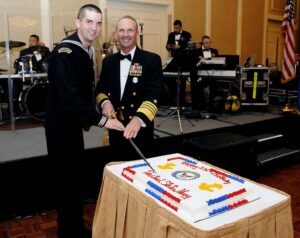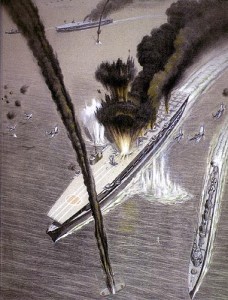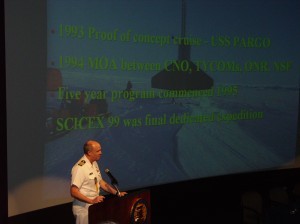- Midway Dinner and Anniversary
- Navy Birthday Celebration
- Submarine Force Birthday History Seminar
- DC War of 1812 Commemoration
In 1999, the Chief of Naval Operations sent a message to the fleet directing the annual commemoration of two significant events in our proud naval history—the birth of our Navy on 13 October 1775, and the U.S. Navy’s World War II victory at Midway from 4 to 7 June, 1942.
Each year, a dedicated group of non-governmental Navy organizations in the Washington, DC-area have banded together as the Battle of Midway Commemoration Committee to help carry out that Navy leadership directive. The groups include:
- The Association of Naval Aviation
- The Association of the United States Navy
- The Naval Historical Foundation
- The Naval Order of the United States
- The Navy League of the United States
- The Surface Navy Association
- The Tailhook Association
- The U.S. Navy Memorial Foundation
In past years the speaker and program have been:
| Date | Speakers | Special Topic |
| 2001 | CNO ADM Vern Clark | |
| 2002 | VCNO ADM William Fallon | |
| 2003 | Former Defense Secretary James Schlesinger | “Midway in Retrospect: The Still Under-Appreciated Victory” |
| 2004 | SECNAV Gordon England | |
| 2005 | Dr. Geoffrey Till | “Midway, Tsushima and Trafalgar: Pivotal Victories at Sea” |
| 2006 | Mr. Evan Thomas | “From Midway to Leyte Gulf: How the Japanese Misjudged the Americans (but almost got away with it) |
| 2007 | Mr. Tom Wildenberg | “Naval Leadership and its Impact on the Battle of Midway” |
| 2008 | Mr. Jonathan Parshall | “Five Fateful Minutes: What Really Happened?” |
| 2009 | Dr. Craig Symonds | “Decisions at Sea: Five Battles that Shaped American History” |
| 2010 | Former Congressman Robert Mrazek | “And the Sky Rained Heroes: The Story of Torpedo Squadron Eight at Midway” |
| 2011 | CNO ADM Gary Roughead | |
| 2012 | CNO ADM Jonathan Greenert Dr. Craig Symonds |
“The War of 1812 and the Battle of Midway“ |
| 2013 | Robert O. Work | “Winning the First Battle After a Period of Prolonged Peace” |
Each year, Navy commands around the world gather to remember the service and sacrifice of those who wrote what Admiral Chester W. Nimitz rightly called “a glorious page in our history.” And what led to that victory?
The Battle of Midway, fought near the Central Pacific atoll of that name, is considered to be one of the most decisive battles of World War II in general and of the Pacific campaign in particular.
From a vantage point of sixty nine years, we look back at Midway as more significant than simply a strategic victory which, as part of a grueling campaign from the battle of the coral sea through the successful capture of Guadalcanal, turned the tide in the Pacific. Historians have suggested that Midway had a broader impact on the outcome of World War II as well as the geo-political configuration of Cold War Europe.
Secretary of Defense James R. Schlesinger asserted at this dinner several years ago, “Midway was far more than a decisive naval victory. It was far more than the turning of the tide in the Pacific war. In a strategic sense, Midway represents one of the turning points of world history – and in that role it remains under-appreciated.”
——————————————————————

Chief of Naval Operations (CNO) Adm. Jonathan Greenert cuts the Navy birthday cake with the youngest Sailor present at the Navy Birthday Ball at the Hilton hotel, Oct. 14. (U.S. Navy photo by Mass Communication Specialist 2nd Class Shannon E. Renfroe/Released)
In June 1999, then-CNO ADM Jay Johnson signed out a NAVADMIN message stating “…the two most significant dates in our naval history are 13 October 1775, the birth of our Navy, and 4 June 1942, the battle of Midway. These two prominent days will henceforth be celebrated annually as the centerpieces of our heritage. During the week of 13 October, all commands are encouraged to participate in birthday activities such as birthday balls and historical seminars to celebrate the origin of our service.”
From 1999 through 2005, the Commandant, Naval District Washington hosted, organized and ran the annual birthday celebration. In 2006, after a series of meetings between representatives of NDW and National Capital Council Navy League (NCCNL) and Naval Historical Foundation (NHF), NCCNL agreed to host the event including issuing invitations, coordinating RSVPs, contracting with the hotel venue, developing the evening sequence of events, inviting senior Navy leadership, printing programs, etc.
NHF agreed co-host the event with a role of providing an annual historic theme for the event, including displaying appropriate historic images and sometimes producing a video about that theme. NHF-sponsored themes have included: Victory in the Cold War; Centennial of the Great White Fleet; Honoring Navy Individual Augmentees in Iraq and Afghanistan; 40th Anniversary of Apollo 11 and Navy in Space; Naval Aviation Centennial; Civil War Sesquicentennial.
The 2012 dinner theme will feature the bicentennial of the War of 1812.
——————————————————————
Submarine Force Birthday History Seminar
Each year, on or close to the U.S. Navy’s Submarine Force 11 April Birthday the Naval Submarine League, with the Naval Historical Foundation and the Naval History and Heritage Command as co-sponsors, produces a Submarine History Seminar in the Washington, DC area. Venues have included the U.S. Navy Memorial’s Naval Heritage Center and the National War College. The evening event includes refreshments, the presentations detailed below, and a ceremonial Submarine Force Birthday cake cutting.
2002 “The Education of Admiral Rickover.”
Biographer Frank Duncan discussed the youth and early career of Admiral Rickover followed by commentaries by his successors, Admiral Kinnaird McKee, USN (Ret.), Admiral Bruce DeMars, USN (Ret.) and Admiral Frank L. “Skip” Bowman, USN.
2003 “Run Silent, Run Deep: A Tribute to the Life of Captain Edward L. Beach.”
Four papers covering aspects of Beach’s life were presented by VADM Al Konetzni, USN; Capt. Jim Hay, USN (Ret.); author Paul Stillwell; and USNA English professor Fred Fetrow. Comments on Captain Beach’s legacy were offered by Naval History Director William Dudley; VADM J. Guy Reynolds, USN (Ret.); former MCPON John Hagan, USN (Ret.); and son Edward A. Beach.
2004 “Nautilus at 50.”
Three papers were presented by Naval Historical Center historian Gary Weir; Capt. Jack Crawford, USN (Ret.), an engineer at Naval Reactors through the development period; and VADM Kenneth Carr, USN (Ret.) a member of the first Nautilus wardroom, on the construction of Nautilus and her impact on naval warfare.
2005 “Raiders from the Deep.”
Three presentations covered the use of submarines as Special Forces delivery platforms. CDR Phil Eckert, USN (Ret.) who served in USS Argonaut, described her raids in World War II, early Cold War operations were detailed by Col. John Ripley, USMC, (Ret.) and current and future capabilities were discussed by Capt. Rick Ruehlin, USN.
2006 “Strategic Systems Programs 50th Anniversary.”
Three presentations covered the 50 year history of the Strategic Systems Programs. RADM Robert Wertheim, USN (Ret.) addressed the early years of the program; VADM Kenneth C. Malley, USN (Ret.) covered the development of Fleet Ballistic Missile Program leading to the Trident Missile; and RADM Charles Young, USN dealt with recent events and current issues.
2007 “Cold War Under the Sea: How Submarine Intelligence Collection Made a Difference—Lessons from the Past.”
VADM Roger Bacon, USN (Ret.), former DCNO for Submarine Warfare; RADM Thomas Brooks, USN (Ret.), former Director of Naval Intelligence; and Mr. Richard Haver, former Deputy Director of Naval Intelligence, spoke about surveillance and reconnaissance operations by USN and allied submarines.
2008 “Fifty Years Under the Ice: A Historical Look at the Scientific, Strategic and Operational Aspects of Submarine Arctic Operations.”
VADM Ken Carr, USN (Ret.) spoke about the Nautilus first polar cruise; CAPT Merrill Dorman, USN (Ret.) covered several decades of arctic operations history; and CAPT Robert Perry, USN detailed recent such operations.
2009 “Submarines in Land Attack.”
CAPT Peter Fullinwider, USN (Ret.) spoke about Regulus missile operations; RADM Walter Locke, USN (Ret.) covered the early years of submarine launched cruise missiles; Ambassador Linton Brooks (CAPT, USN (Ret.) dealt with submarine launched cruise missile policy.
2010 “Ocean Surveillance During the Cold War: Sensing, Fusion, Exploitation.”
CAPT William Manthorpe, USN (Ret.), former Deputy Director of Naval Intelligence moderated the seminar. RADM Thomas A. Brooks, USN (Ret.), former Director of Naval Intelligence spoke about the “sensing” of the Ocean Surveillance Information System (OSIS); “fusion” was covered by CAPT James Donovan, USN (Ret.), former commanding officer of Naval Ocean Processing Facility Dam Neck, describing the Sound Surveillance System (SOSUS); and RADM Eric A. McVadon, USN (Ret.), former Commander, Iceland Defense Force spoke about Cold War maritime patrol aircraft exploitation of the information gathered on Soviet submarine operations.
2011 “The Rise of the Submarine Launched Ballistic Missile.”
Led by moderator CAPT Pete Boyne, former Deputy Director of Strategic Systems Programs (SSP), a distinguished panel discussed the concept, development, and operational deployment of the SLBM nuclear weapons deterrent. The panel consisted of Mr. Franklin Miller, Former Senior Director for Defense Policy and Arms Control, National Security Council; VADM Jerry Miller, USN (Ret), author of “Stockpile” and “Nuclear Weapons and Aircraft Carriers” and former Deputy Director Joint Strategic Target Planning Staff; and Mr. Phillip Lantz, founder, President and CEO of Systems Planning and Analysis, Inc.
2012 “OUTLAW SHARK – The Beginning of Over-The-Horizon Targeting.”
The 2012 Submarine History Seminar was held on the evening of 24 April 2012, as part of the National War College Commandant’s Lecture Series in historic Roosevelt Hall at the War College’s Fort McNair campus in southwest Washington, DC. 2012 marks the 11th year that the Naval Historical Foundation has partnered with the Naval Submarine League and the Naval History and Heritage Command to stage these compelling looks back at the U.S. Navy’s submarine force in war and peace. The seminar took an in-depth look back at the intensive effort in the 1970s and 1980s to develop over-the-horizon (OTH) targeting methods needed to ensure that newly developed HARPOON and TOMAHAWK cruise missiles could be employed reliably to their full range potentials.
Moderated by NHF Vice President RADM Jerry Holland, USN (Ret), panelists included:
- RADM Guy Shaffer, USN (Ret), who had served for five years as Director, Navy Command and Control and Communications Projects for the Naval Electronics Systems Command in the 1970s;
- RADM Walter Locke, USN (Ret), who had served as Director of the Joint Cruise Missiles Project from 1977-1982;
- Dr. (and retired Navy CAPT) Robert Hess, who directed and performed contract analyses in areas of ocean surveillance, OTH targeting, command and control and related fields for numerous Navy and DoD offices in the 1970s and 1980s;
- CAPT Lynn Wessman, USN (Ret.), who served as project officer for OUTLAW SHARK at Submarine Group Eight in Naples, Italy in the late 1970s.
The audience of nearly 70 active duty and retired Navy personnel, plus eight midshipmen of the Naval Academy’s Dolphin Club, listened with rapt attention to the participants’ descriptions of the U.S. Navy’s ultimately successful effort to target the Soviet Navy before they were able to develop the same capability to target USN ships.
The seminar was preceded by food and refreshments sponsored again this year by the Northrop Grumman Marine Systems office.
2013 “Seawolf and The Maritime Strategy: Examining the Relationships of Policy, Strategy, Technology, Tactics and Acquisition.”
On 11 April 2013, nearly 120 guests attended the Submarine History Seminar in the Navy Museum’s Cold War Gallery to hear how the U.S. Navy’s posture changed from the Carter years of being a reactionary one that assumed the Soviet Navy would replay the role of the Germans in fighting a Battle of the Atlantic III, to a proactive strategy during the Reagan years that aimed at attacking Soviet ballistic missile submarines at the onset of war. A key was a realization by American Navy leaders that the Soviets had little interest in using their submarine forces to interdict allied operations in the North Atlantic. This shift in American thinking on how to employ forces in a general war with the Soviet Union became known as “The Maritime Strategy” and the Seawolf submarine, of which only three were built, was designed as a big, fast, quiet, torpedo-laden weapon system that could effectively operate in hostile waters.
The participants were asked to address the following questions:
- Did any technical development or acquisition requirement stem from a policy decision or strategic direction?
- What if any tactical operational results or requirements influence policy decisions or strategic direction?
- If the policy or strategy directions did not specifically influence the Seawolf design, what or who made the design tradeoffs and decided the ship’s characteristics?
- How much, if any, did the Maritime Strategy fundamentals influence the deployments and operations of submarines in the rest of the Cold War? (Before and after open publication).
- When did the Soviets recognize any vulnerability to the Maritime Strategy? Did that recognition reach their national leadership?
- Was the Maritime Strategy ever acknowledged by Office of the Secretary of Defense (OSD) or political leaders of the Administration (other than Secretary Lehman)? Did the strategy have any impact on these civilian officials or was it simply an internal/external Navy document?
- How influential was the Maritime Strategy on the design and acquisition of ships and weapons? (Seawolf as the anti-bastion cracker, expansion of MPA, deployment of S3, creation of Aegis).
- Did the long term on-going submarine operations themselves influence the Maritime Strategy?
- In the actual plans that reflected the Maritime Strategy, submarines were seen as the leading edge of the assault on Soviet Navy. When was this offensive concept extended to other parts of the Navy? (i.e. Exercise Northern Wedding).
To address the questions, three distinguished individuals, with moderator RADM Jerry Holland, USN (Ret.) discussed the design of Seawolf and the evolving thought process that led to the Maritime Strategy.
- RADM Millard S. Firebaugh, USN (Ret.) served as an engineering duty officer and was assigned to the Naval Sea Systems Command during the early 1980s. There he initiated the Seawolf Class submarine program which he managed through design and award of contracts for the first two ships of the class.
- CAPT Peter Swartz, USN, (Ret.) served in the Navy as a General Unrestricted Line Officer, worked in the Chief of Naval Operations and Secretary of the Navy’s staffs in the 1980s, contributing to the development and dissemination of The Maritime Strategy.
- Ambassador Linton F. Brooks has over five decades of national security experience, much of it associated with nuclear weapons and deterrence. As an active duty Navy captain he served on the Navy staff and the National Security Council staff in the 1980s, where he has active in shaping and promoting the Maritime Strategy.
——————————————————————
The Naval Historical Foundation is partnering with several museums and institutions in the VA-MD-DC area to commemorate the 200th anniversary of the devastating burning of Washington, followed by the penning of the Star Spangled BAnner by Francis Scott Key and the decision to rebuilt our new nation’s capital as a symbol of American pride and independence.
A variety of commemorative events will take place this year in our nation’s history, museums, archives, libraries, historic sites, and neighborhood associations across the National Capitol Region during this “Star Spangled Summer.”
For a full list of events and information about the DC 1812 Commemoration, please go to dcwarof1812.org.




